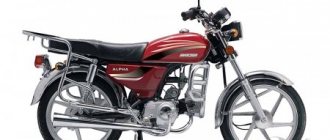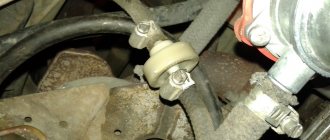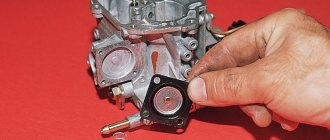Experienced motorcyclists have faced the problem many times: the spark plugs are filled with fuel! This article is intended for those who have encountered such difficulties for the first time. Together we will find out the cause of this unpleasant phenomenon, and also figure out ways to fix the problem and methods to prevent the candles from flooding again.
How to avoid flooding spark plugs with gasoline?
The most important criterion is to maintain the battery charge and the functionality of the starter. For this, sufficient conditions are created for the scooter to start even on the frostiest morning. In addition, you should fill in high-quality oil and use high-quality gasoline with a sufficient octane number, as specified in the operating manual of the purchased scooter. As a preventative measure, it is worth cleaning and adjusting the injector nozzles.
People's Council
To prevent the spark plug from flooding with gasoline during the cold season, you should occasionally “spin” your scooter to maximum and move at a speed slightly above average, thus increasing the load on the scooter’s engine at high speeds, due to which self-cleaning of carbon deposits and excess in the combustion chamber occurs.
By fulfilling all these basic requirements, you can not only eliminate problems associated with filling spark plugs with gasoline, but also increase the service life of your scooter’s engine significantly. By following all the above instructions, you will not have to contact a car service center again for expensive service.
Experienced vehicle owners know that in the cold season, for some reason, sometimes the scooter does not start. Some people find themselves in such an unpleasant situation in the summer, but much less often. The problem can have many causes, but the most common is a flooded spark plug.
This can happen regardless of the fuel injection system, injector or carburetor, installed on your scooter. The design of the spark plug and methods for troubleshooting the problem do not change significantly.
Eliminating the causes of the malfunction
If after performing the manipulations the scooter starts, that’s good, but you shouldn’t relax. Be sure to check for possible faults. What to do to prevent this situation from happening again:
- Clean or replace the air filter. You can make sure that this is the reason by simply trying to start the engine with the filter installed and without it.
The air filter can be covered with a foam cover - Refuel only with high-quality fuel at trusted gas stations. After refueling at some stations, I had to clean the carburetor jets every time.
- Check the condition of the spark plug. Pay attention to the gaps between the electrodes, the amount of carbon deposits and check the spark. The spark is checked as follows: a candle holder is put on the unscrewed spark plug, the thread is leaned against the cylinder and the engine is turned by the starter. In this case, the candle should give a powerful spark. If the spark is weak, adjust the gap; adjusting the gap does not help, change the spark plug. If the new spark plug produces a weak spark, then you need to pay attention to the ignition coil.
To check for a spark, place the spark plug against a metal housing and turn the starter
Why does a spark plug on a scooter flood and what should I do?
1 Why does the spark plug on a scooter flood and what should I do?
- Scooters often encounter this problem when the spark plug is flooded, when yesterday their favorite mode of transport started and drove well, but today they just can’t start it.
When you unscrew the spark plug, it turns out that it is wet with gasoline.The main reason why a spark plug is flooded with fuel can be called the quality of the spark plug itself. Try changing it.
The second reason is the quality of the fuel. As we know, it is not always possible to buy high-quality fuel at a gas station, and therefore impurities cause contamination of the spark plug and, in the end, it stops producing a spark of the required charge.
Another important reason is a weakly charged battery. Charge the battery or replace it with a new one.
Poor quality oil, which is used in scooters, can also cause contamination of the spark plug and therefore fill it with gasoline.
Don't forget about the quality of the high voltage cable. If it is broken, there will be a weak spark or no spark at all and the spark plug will be filled with gasoline.
- If the scooter does not start, there can be many reasons, but quite often it happens because the spark plug is filled with gasoline. An unscrewed wet spark plug will confirm this.
What to do if the scooter does not start?
There are times when scooter owners are faced with the problem that it will not start. The reasons for this can be different, but there are also quite typical ones. In some cases, fixing the problem takes a few minutes.
Let's look at several reasons that lead to the scooter not starting. All examples are real, obtained during the repair of the Chinese scooter ABM Storm L and Motoland VXR5 .
The scooter does not start with the button.
If the scooter does not, but starts from the kickstarter without problems (from the “leg”), then you should pay attention to the main fuse, which is located in the battery compartment.
This same fuse may be the cause. There was a real case when, when measuring the voltage at the battery terminals, 13 volts was displayed on the multimeter display. The norm, considering that the battery was slightly discharged.
When measuring the voltage after the fuse, the multimeter showed 12.8 volts. Wonderful, isn't it? Does a piece of wire (fuse) really drop 0.2 volts? In theory, this shouldn't happen. The voltage in the scooter's electrical network after the ignition switch was also measured. The voltage was a little more than 5 volts and was fluctuating. The turn signal relay also began to crackle ungodly after the scooter was started with the kickstarter and the turn signals were turned on.
Due to the fact that the fuse was made, to put it mildly, poorly, the wire inside the glass bulb barely touched the contact caps. Because of this, the electrical contact in the fuse was poor. This is where those 0.2 volts of voltage were lost.
Due to the fact that the turn relay received undervoltage, it crackled, since the supply voltage was sometimes enough to operate the electromagnetic relay, sometimes not.
Also, when pressing the “Start” button, the starter, which spins the engine shaft when starting, did not start. Naturally, since the voltage in the scooter's electrical network was underestimated due to a faulty fuse.
After replacing the faulty fuse, the scooter began to start with the “Start” button.
In case of such malfunctions, you should first check the integrity of the connecting conductors in the engine starting circuit. If you don't have a scooter wiring diagram handy, take a look here. There you will find a scooter wiring diagram that is suitable for almost all Chinese scooters.
Let's look at another problem.
The scooter does not start either from the start button or from the kickstarter.
What could be the problem?
Many people encounter this problem when they try to start a scooter after winter. In this case, the scooter seizes, but does not start. The electric starter turns, but something is missing to start the engine itself. The cause may be old fuel left in the gas tank. It is better to drain the old fuel and fill the tank with new one.
Why does the carburetor on a scooter flood?
- Check the shut-off needle in the float chamber. Dirt can get under it and jam it, so the needle can no longer close the hole tightly and the fuel supply to the carburetor is disrupted. In this case, fuel may leak even if the engine is turned off. Also check the tongue on the floats. It may be bent or vice versa, this also disrupts the fuel supply. In general, you need to be very careful with these things. There is no need to go there without a good reason.
- If option 1 did not help, then the next reason why the carburetor on a scooter is flooded is the vacuum valve , or rather its malfunction. This is a kind of pump that can simply pass fuel into the carburetor, which leads to carburetor flooding. The vacuum valve may not perform its functions due to a cracked membrane. As a rule, the reason why the carburetor on a scooter is flooded is one of the first two. Although it may also be that the air filter is clogged. In this case, no air will flow into the carburetor, there will be no pressure, this can lead to carburetor overflow.
- If the carburetor is filled through the air filter , then this can be easily checked. You just need to remove the filter. If after this the problem is solved, then the problem is in the filter and you need to clean it.
- And as an option, although extremely rare, the jets are clogged. In this case, you just need to clean the carburetor , this will solve the problem.
We looked at the most important and common problems. If you have any questions, you can leave them in the comments.
Checking the batteries
If the scooter does not start in both cold and warm weather, the owner should check: the gas tank, enrichment, tap, filter, carburetor and pump.
First, it is recommended to diagnose the fuel tap. To do this, you need to disconnect the hose from the carburetor and turn the crankshaft. If everything is in order, gasoline will begin to flow out of the tube. But if the fuel does not drain or flows even when the engine is not running, then the valve should be replaced.
The second stage of diagnosing the power system is inspecting the fuel filter. If a component becomes clogged, it should be replaced. But even if the filter is clean, but it is not blown out, it means that a blockage has formed in it.
Due to contamination of the carburetor, problems with starting the engine may also occur. The cause of the blockage is low-quality gasoline or an ineffective filter. To solve the problem you need to:
- Remove and disassemble the carburetor.
- Blow out and clean all openings. For cleaning, use a compressed air cylinder or a simple compressor.
- Check the float chamber and its components.
- Clean the fuel jet.
It is also worth remembering about the most banal problems - lack of fuel or old gasoline. If after a long period of inactivity the scooter does not start from the button, you should drain the old gasoline and fill the tank with fresh fuel.
The third reason is the generator
If after replacing the ignition coil and switch the spark does not appear, then we check the generator. Here we need a multimeter. We set the device to the diode position, remove the generator chip and begin the test. Two wires are responsible for the spark:
- blue with a white stripe is a hall sensor;
- black with a red stripe is the coil on the generator.
Generator chip
Checking the hall sensor. We connect the probe from the device to the blue wire with a white stripe. And we connect the other probe to engine ground. Numbers should appear on the device, indicating that the hall sensor is working.
We do the same work with the coil on the generator. If the numbers are displayed on the device, then the coil on the generator is working. If nothing happens on the device, then you will have to change the generator or hall sensor.
Scooter rider
A scooter can have many breakdowns and malfunctions and they always arrive at the wrong time. One of these breakdowns is when the carburetor on a scooter floods. In this article we will look at the following questions: – Why the carburetor on a scooter floods – Symptoms of a carburetor on a scooter flooding – How to fix this problem
Symptoms of a flooded carburetor on a scooter
If the carburetor is flooded , this can be determined in simple ways. The manufacturer of your vehicle is of great importance. Because Japanese scooters are very different from Chinese ones. In our case, the main symptom that the carburetor is flooded in a scooter is a wet spark plug. If the scooter stalls, jerks, or does not work confidently, you need to check the spark plug. If you have a Chinese scooter , then in addition to a wet spark plug, you may find that gasoline is leaking from the air filter. First you need to check that the valve clearances are set correctly. If everything is fine with this, then we are looking for what could be wrong.
Sequence of repair actions
The main rule for detecting malfunctions and repairing a scooter is to step-by-step eliminate the elements of the system when identifying the causes of a breakdown in any of them. Search and repair, especially when starting from the starter, must be done in accordance with a strict sequence, where the chain may act as the beginning, and the end, for example, if there is or is no spark. It is worth noting that you do not need to immediately run for a new switch for the scooter, first make sure that the generator is functioning perfectly, only after that test the wiring if there is no spark, etc.
Checking Basic Systems
It is important to remember that gasoline has the ability to lose its properties if it sits in cold weather and may not even ignite. Also, before making a final diagnosis and starting to repair the moped, if it does not start from the starter, you need to make sure that the spark plug can do its job and the carburetor is functioning normally
Remember that the scooter starts from the starter when it has an integral part with proper operation of the variator, clutch, camshaft group and valve. To put it simply, if all power systems are in normal condition, then there is a problem in the transmission, thanks to the crankshaft torque, which works closely with the variator.
In the process of diagnosing and repairing a scooter, in some cases it is necessary to do a thorough check of not only individual elements, but also the entire system. For example, if there is debris in the carburetor, provided that it is intact and the air filter is saturated, the presence of dirt in the cavity of the gas tank and the fuel filter is also carefully examined.
How to start the engine
If yesterday the scooter was working as usual, but today it doesn’t even start, then most likely the reason for this is hidden in the spark plugs. New owners of such a vehicle do not know how to start the engine. There are two ways to solve this problem. First: take out and dry the candles. But if there is not enough time, then the second option is also suitable: initially you need to leave the scooter for 5 minutes. After this, completely unscrew the throttle and turn the starter. Continue for approximately 15 seconds. At this time, the fuel supply to the chamber will stop and it will be purged with air. This should be enough to start the engine. This method is suitable for those who have a 4T Chinese scooter and who are wondering what to do with a 2T scooter.
If this method does not work, you can try drying the candles. To do this, you need to unscrew these elements, clean the carbon deposits with a brush, and dry them with a hairdryer in the oven or on the stove. When screwing the spark plugs into place, you need to control the gap. After this, the engine should start.
Attention!
If the vehicle is not new, then the spark plugs need to be cleaned more often, or better yet, replaced.
If the spark plugs are constantly filled with gasoline, then diagnostics are required. The spark plugs must be checked for spark quality, the cleanliness of the injectors, and the spark output from the ignition coils must be diagnosed. The Hall sensor is also subject to testing.
What to do when the candles are filled with a flammable mixture?
Currently, there are two options for solving this problem. The first is based on the instruction manual, which states that when filling the injector spark plugs with gasoline, they should be unscrewed and dried. Once they have dried, you need to spin the starter for 10-15 seconds, and after that, screw the spark plugs back in and try to start the engine.
The second method can rightly be called popular - before unscrewing the spark plugs, you should test the engine in the purge mode. This can be done by unscrewing the throttle completely for 10-12 seconds, as a result of which the starter spins completely. Then release the throttle, the engine should start. This procedure closes the gasoline supply and thereby blows air through the spark plug.
If after this operation you still cannot start the engine of your scooter, then you can resort to drying the spark plug. Since spark plugs for injectors are not structurally different from spark plugs for a carburetor type engine, cleaning will proceed in the same way. To do this, you need to unscrew the candles, clean them of carbon deposits with a brush, then dry them in any convenient way - in the oven, on a gas stove or with a hairdryer. After all the manipulations and installing the spark plug back into place, the engine should start. Also, you should not have any problems with why the scooter is smoking.
If cleaning does not help and it is clearly visible that the spark plug is many years old and it is not possible to bring it into proper condition, then you should think about replacing it. To avoid having to change spark plugs in the future, it is worth carrying out preventive maintenance and cleaning them from dirt as often as possible.
If none of the proposed methods helps and the spark plugs are filled with gasoline regularly, then diagnostics should be carried out. It can include checking the quality of the spark supply of the candles and its output from the ignition coil. Also pay special attention to checking the injector for cleanliness and monitor the functionality of the Hall sensor.
Circumstances under which the spark plugs will not fill with gasoline
Of course, these are exemplary conditions, but you can check many of them so that you don’t have to face the morning in a minibus or metro while going about your business.
So, the key criteria are:
- well charged battery and working starter
- high-quality oil with appropriate parameters for the frosty season
- spark plugs and high voltage cable are of high quality and trouble-free
- The injector nozzles were cleaned and adjusted in a timely manner. Preferably not with the help of various additives in the tank, but with the use of equipment for cleaning injectors
- high quality gasoline
People's advice: if you want the engine to start perfectly in cold weather and the spark plugs not to be filled with fuel, the engine must be “twisted” periodically, once a month. Distance 50-100 km at above average speed and on good fuel.
Or once every two days, while moving, give the motor a load at increased speed for 10 seconds so that self-cleaning of carbon deposits and deposits in the chamber occurs.
These conditions are easy to control on your own, without the help of car service professionals.
Results
It is easier to prevent trouble than to deal with repairs later. To do this, it is worth spinning the engine about once a month and moving at high speeds. This way you can clean the chamber of carbon deposits. A charged battery, high-quality fuel and regular care will help you avoid unpleasant situations. Honda Dio or Suzuki, your scooter will serve you well.
Sources used:
- https://skuterov.ru/remont/zalivaet-svechu-na-skutere
- https://proscootera.ru/masterskaya/remont/pochemu-zalivaet-svechu-na-skutere-i-kak-eto-ispravit
- https://avtomoto-best.ru/pochemu-zalivaet-svechu-na-skutere.html
- https://scoteram.ru/neispravnosti/zalivaet-svechu-na-skutere.html
Reasons for flooded spark plugs on the carburetor and injector
The main cause of the problem is considered to be incorrect operation of the “electronic brain” of the scooter.
At minus, to start the scooter, more force is required to mix the air-fuel mixture. This is due to the fact that at negative temperatures, a large amount of oxygen requires much more fuel. The “electronic brains” of the scooter see the problem arising and give a command to the injector nozzle to increase the supply of the combustible mixture. It is because of this that a problem arises in the engine compartment of your vehicle, especially if the battery on the scooter is not new. When gasoline is supplied by injectors to the combustion chamber, the starter tries to create sufficient compression in the cylinders and at the same time tries to produce a spark to create a flash. In combination with low-quality gasoline and the previously mentioned process, insufficient compression is created, due to which the scooter cannot be started. Only with perfect compression, which only a new scooter can boast, is it possible to avoid flooding of the injector spark plugs and start the scooter engine even with small impulses.
It is not difficult to guess that at sub-zero temperatures a weak spark is formed, the compression is insufficient, while the injectors supply a large amount of gasoline into the combustion chamber and it is for this reason that the spark plug is flooded with a combustible mixture, as a result of which the scooter does not show signs of life.
What to do if soot appears
First of all, it is necessary to remember that oil contamination and overheating, which results in soot on the spark plugs, are very harmful to the ignition system . Overheating is especially dangerous, since it causes the possibility of failure of the electrodes on the spark plugs without the possibility of their restoration.
If your car only has one blackened spark plug, you can diagnose the breakdown by simply swapping the spark plugs. If after this the new spark plug also turns black and the old one clears up, it means that the problem is not in the spark plugs, but in the cylinder. And if nothing has changed, then questions arise about the performance of the candle itself.
Oil deposits
In some cases, the candles may be wet and black. Most often, the reason for this fact is oil getting into the combustion chamber. Additional symptoms of this problem are as follows:
Oil on candle
- difficulty starting the engine;
- omissions in the operation of the corresponding cylinder;
- the engine jerks during operation;
- the appearance of blue smoke from the exhaust.
Oil can enter the combustion chamber in two ways - from below or from above. In the first case, it enters through the piston rings. And this is a very bad sign, because it often threatens a major engine overhaul . In rare cases, you can get by with decoking the engine. If oil enters the combustion chamber through the top, it comes from the cylinder head along the valve guides. The reason for this is the wear of the valve stem seals. To eliminate this problem, you just need to select new, high-quality caps and replace them.
Carbon deposits on the insulator
Red carbon deposits on a candle
In some cases, carbon deposits that naturally appear in the combustion chamber can come off the piston at high engine speeds and stick to the spark plug insulator. The consequence of this will be gaps in the operation of the corresponding cylinder. The engine will “trouble” in this case. This is the most harmless situation why spark plugs turn black. You can eliminate it simply by cleaning their surface or replacing it with new ones.
If black and red spark plugs , this means that you are pouring fuel with an excessive amount of metal additives. It cannot be used for a long time because over time, metal deposits form a conductive coating on the surface of the spark plug insulator. Sparking will deteriorate and the spark plug will soon fail.
Cleaning spark plugs
Exhaust pipe clogged with carbon deposits
In this situation, the scooter does not pull at all and stalls.
You need to remove the pipe and check it for ventilation. There may be carbon deposits inside the pipe or some partition has broken off, blocking the exhaust.
You can also check the pipe without removing it from the scooter: at idle, if the pipe is not clogged, the smoke comes out in a pulsation, approximately at the beat of the engine.
And if the pipe is clogged, then the smoke comes out at high speed in a continuous stream. This indicates a reduction in the throughput hole in the exhaust pipe.
Signs of problems with the fuel level in the carburetor
Before starting to repair any component of a car or other vehicle, it is important to make sure that the problem is caused by a particular component. In the case when the carburetor is flooded, checking the malfunction of this particular unit is very simple - just analyze the behavior of the car and pay attention to some aspects of its functioning. In particular, if there is a problem with fuel supply, the following will be observed:
- difficulty starting the engine, especially with a well-warmed-up engine;
- unstable or high idle speed;
- problems with setting “idles”;
- streams or real puffs of black smoke from the exhaust pipe;
- dips with medium and strong pressure on the gas pedal;
- black velvety soot on the spark plugs.
Note that such symptoms are also observed when fuel is overflowed from the carburetor of a chainsaw, a motorcycle, a moped, a car, and even on a walk-behind tractor. However, in units with a small and, as a rule, parallel fuel system, such as a multicultivator, moped or scooter, another sign is also observed - the presence of gasoline in the air filter. If such a symptom occurs, then we can guarantee that the carburetor is overflowing and requires taking some measures.
Troubleshooting Methods
Most often, if fuel leaks from the filter, owners rush to change the carburetor. The mistakes of this approach to repair are:
- gasoline may enter the air filter not only due to the fault of the carburetor, so replacing it with a new one may not eliminate the problem;
- ridding the float chamber of debris is not a labor-intensive process and is carried out without resorting to financial costs;
- revising the settings of the quality and quantity screws can eliminate the malfunction without dismantling the carburetor.
Therefore, to correct the problem, it is recommended to adhere to the following action plan:
- If there has been interference with the idle speed or mixture settings, check that they are set correctly;
- Check the operation of the vacuum valve. When closed, fuel should not pass through;
- Check the electronic starter enrichment. After turning it off, you need to test run the engine;
- Remove the carburetor and disassemble it;
- If no significant wear, deformation, or damage is visible, blow it out. If plaque or fallen resins are visually detected, the float chamber will need to be flushed;
- Some fuel system designs include a reed valve. It has low maintainability, especially when made of metal. If any bent is found, it is recommended to replace it with a new one.
It is necessary to change the carburetor only if it begins to throw fuel due to excessive wear. In this case, the vehicle has a solid mileage on the odometer and gasoline begins to be thrown into the air filter not unexpectedly, but gradually with increasing volume. Initially, you can only notice the smell, but over time the amount of fuel in the filter can reach 100 - 150 grams.
The most unpleasant situation is when the valve burns out and excessive pressure occurs, pushing fuel into the filter. This situation happens extremely rarely, but you shouldn’t discard it when looking for a breakdown. For diagnosis, it is enough to measure the compression. If its value is low, the engine should be repaired.
Soot contamination
Type of spark plug: dry soft soot of intense black color on the insulator, electrodes and spark plug body.
Consequences: poor start of the scooter engine; poor operation of a cold scooter engine; interruptions in ignition of the air-fuel mixture; bad reaction to gas.
Probable causes: excessively rich air-fuel mixture; The scooter's air filter is very clogged; The thermal range is incorrectly selected - the candle is too “cold”.
Remedy: adjust the working mixture; adjust the cold start system of the scooter engine; change the scooter air filter; clean the spark plugs or replace them with new ones - with the correct heat rating.
We are trying to start the engine
So, we figured out why the spark plug on the scooter floods. The repair methods and starting methods below apply to scooters with 2T and 4T engines.
- The method is suitable if there is no tool. If you flooded the spark plug while trying to start the scooter, then give it time to stand for about 5 minutes. Then turn the gas handle all the way and turn the engine with the starter for about 10 seconds. You can use the foot several times if the starter is faulty. Release the throttle and try to start the engine again - it should work.
- If you have a spark plug wrench, you should unscrew the spark plug and warm it up over a fire, after cleaning it from carbon deposits. With the spark plug removed, you should “blow out” the cylinder by rotating the engine with the starter or foot. Screw in the spark plug and try to start. If unsuccessful, the spark plugs should be replaced.
Advice! Although the first method is faster, it is still recommended to use the second. This cleaning of the ignition system will help avoid such problems for some time.
Checking Basic Systems
In order to understand why the scooter does not start, the problem must be looked for sequentially:
- Start with the simplest thing - check the battery charge, if it is normal, proceed further.
- Check if the scooter has gas; it’s easy to forget to fill up.
- See if gasoline is flowing into the carburetor.
- Unscrew the spark plug, inspect it and check if there is a spark.
- If the spark plug is in order, check the coil in the manner described above, turning the starter with the spark plug removed.
- We check the coil and wiring with a multimeter, there may be a break.
- Clean the carburetor and adjust it correctly.
Supply system
After checking the electrics and making sure that everything is in order, you should get to the power system: if the fuel is supplied in the wrong amount, the scooter may not start. If there is a large amount of fuel, the carburetor overflows and the spark plug becomes wet, and if there is little fuel, there is not enough of it for the piston to move. To do this, you need to adjust the jet, floats and needle, moving the limiter on it. It wouldn't hurt to check the gasoline pump either: sometimes it simply fails, so the fuel doesn't go anywhere.
Ignition system
The entire ignition system must be checked if there was a spark and then disappeared. If the spark plug and coil are normal, but there is still no spark, you will have to check more thoroughly. The coil, generator winding, and switch come under suspicion. A multimeter can check all this: for example, they test a generator like this - one probe is connected to the engine crankcase, the second to the generator sensor.
The resistance of a working sensor is 500 Ohms. If the value is higher, the winding is faulty; if it is below 200 Ohms, the problem is in the coil.











